Baguette or French bread, how to make it at home easy step by step

The baguette The traditional French bread bakery is one of the Holy Grails of the bakery, a preparation to which all bakers, professionals and amateurs alike, come to test themselves and show the world their good work, with a crusty loaf on the outside and with a crumb silky, and with the right alveolate. It is not easy to get baguette perfect.
Go ahead that our version is a baguette walking around the house, but, as you can see if you prepare it, it is very satisfying, with a wonderful flavor. This bread with crispy crust and silky crumb It is so addictive that you will not be able to stop eating it. To give the bread the best flavor, we use a preferment type poolish: a portion of the flour and water (in equal proportions) from the recipe, which we put to ferment the night before with very little yeast. The slow fermentation of this portion of dough enhances the flavor of the baguette and improves the extensibility of the dough.
As we said, the baguette Requires caution and some experience in handling sourdoughs; The shaping has its intricacies, which we try to reflect in the manufacturing photos, as well as the weaving so that the bars open beautifully. It is not easy to master it, the hair that you see in the photos can clearly be improved, but that gives us reason to repeat the baguettes until they are teachers, ahem.
Since it is not easy to stuff a baguette of standard length, like those that we see natives carry under their arms in France, in this recipe we will prepare some baguettes somewhat shorter than they should be, so as not to have to fight with oven trays or racks. In French law, loaf bread is divided according to its weight, into the following four categories:
-
- Ficelle 100g
-
- flute 200g
-
- baguette 250g
-
- Pain tradition 300g
With the quantities that we use in the recipe divided between three loaves, we obtain a loaf between the baguette and the flute, in matter of weight.
Tips for making baguettes
It is important carefully follow the instructions for preforming and shaping the barsas indicated in the recipe, since proper shaping greatly influences whether the baguettes grow properly during cooking and look good.
For cooking the baguettesit is convenient to create steam in the oven, in order to delay the formation of the crust and improve the appearance of the bars. Steam can be generated in the oven in two ways: the first, placing a tray with water at the bottom of the oven just before putting the bread in; the second, heating a tray with volcanic gravel in the oven, at the same time that it is heated. Just after introducing the bread, this volcanic stone is sprayed with boiling water, which produces abundant steam.
recipe information
-
- Preparation time: 20 hours
-
- cooking time: 35 minutes
-
- total time: 20 hours 35 minutes
-
- rations: 3
-
- Category: loaves
-
- type of cuisine: French
-
- Calories per serving (kcal):460
ingredients of the baguettes for 3 units of about 30 cm
For the preference:
-
- 120 g of wheat flour for bread
-
- 120g of water
-
- 0.3 g dry baker’s yeast (1 g fresh yeast)
For the main dough:
-
- all preferment
-
- 275 g of wheat flour for bread
-
- 140g of water
-
- 8g of salt
-
- 1 g dry baker’s yeast (3 g fresh yeast)
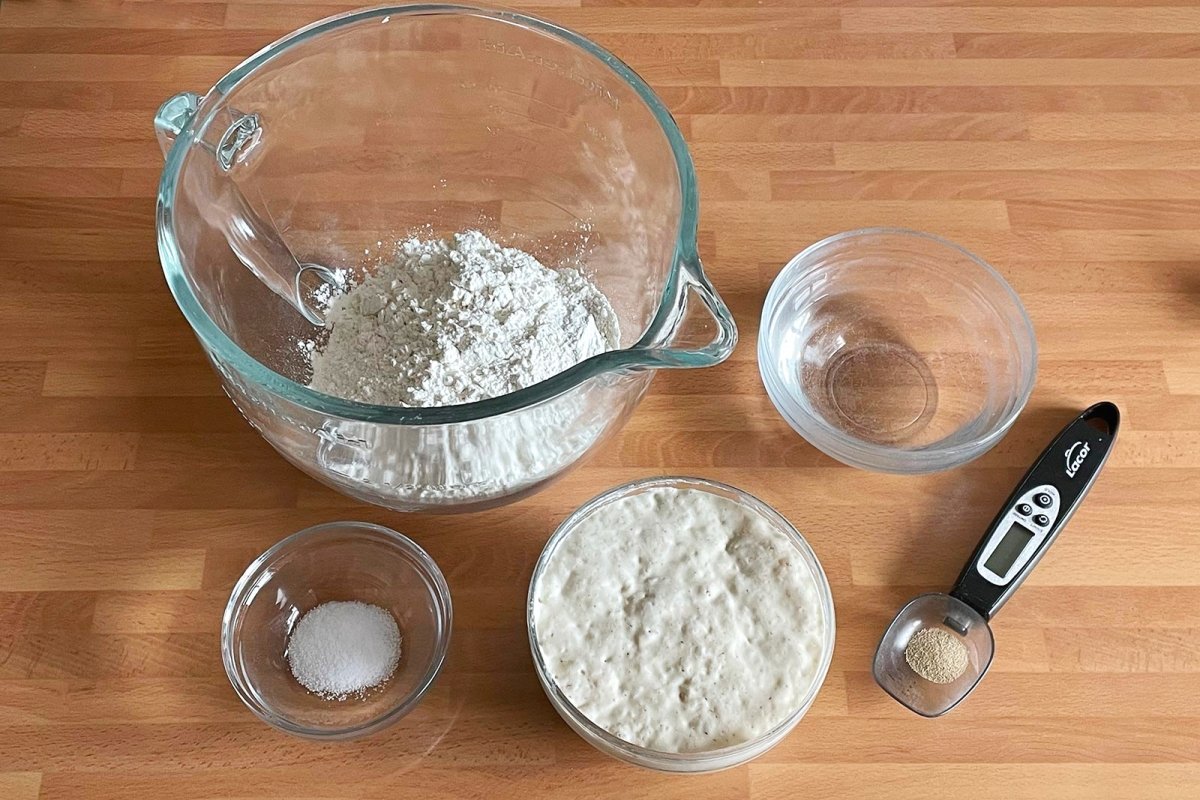
How to do baguettes (French bread)
How to prepare the preferment for baguettes
Weigh all the ingredients of the preferment. Put 120 g of bread flour together with 120 g of water at room temperature and 0.3 g of dry baker’s yeast (or 1 g of fresh yeast) in a bowl. Mix until you get a porridge and cover with plastic film. Let ferment for at least 12 hours (since the night before), until it is bubbly.
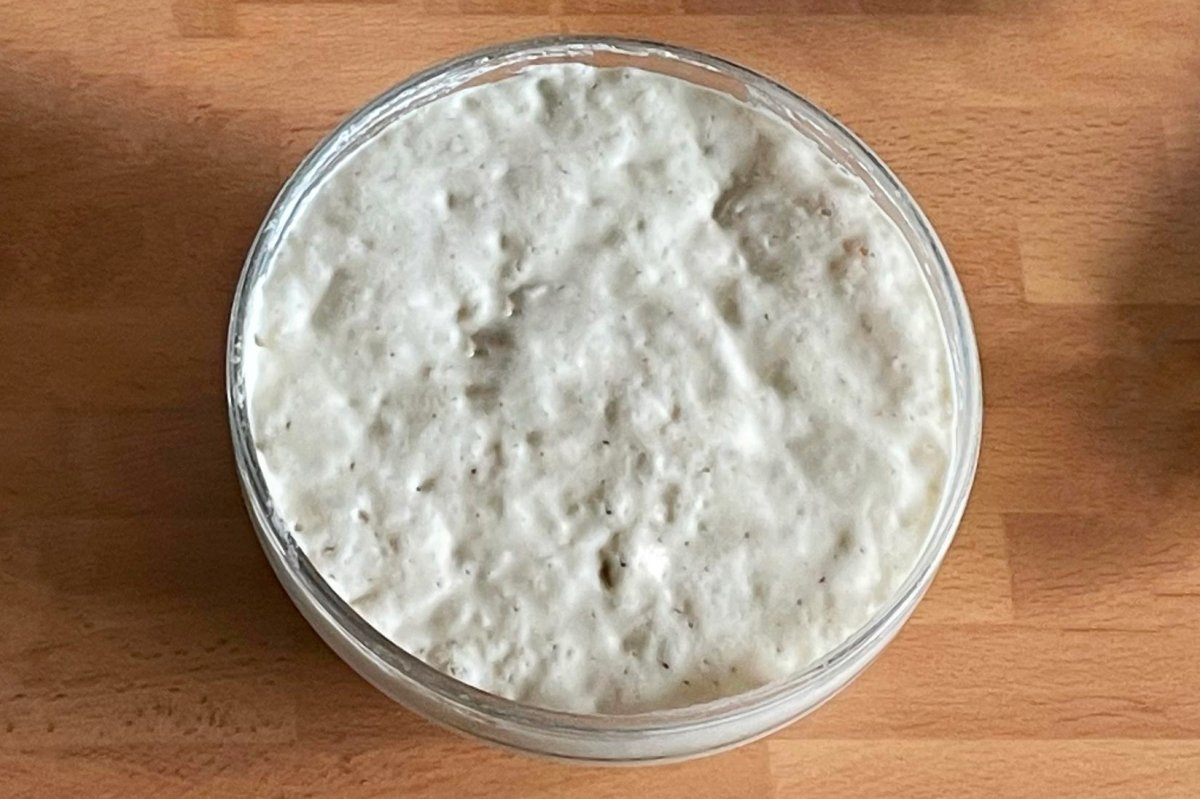
How to prepare the final dough baguettes
Weigh all the ingredients of the final dough. Put the preferment in a large bowl with only 275 g of additional bread flour and 140 g of water, and mix with a scraper or with a robot.
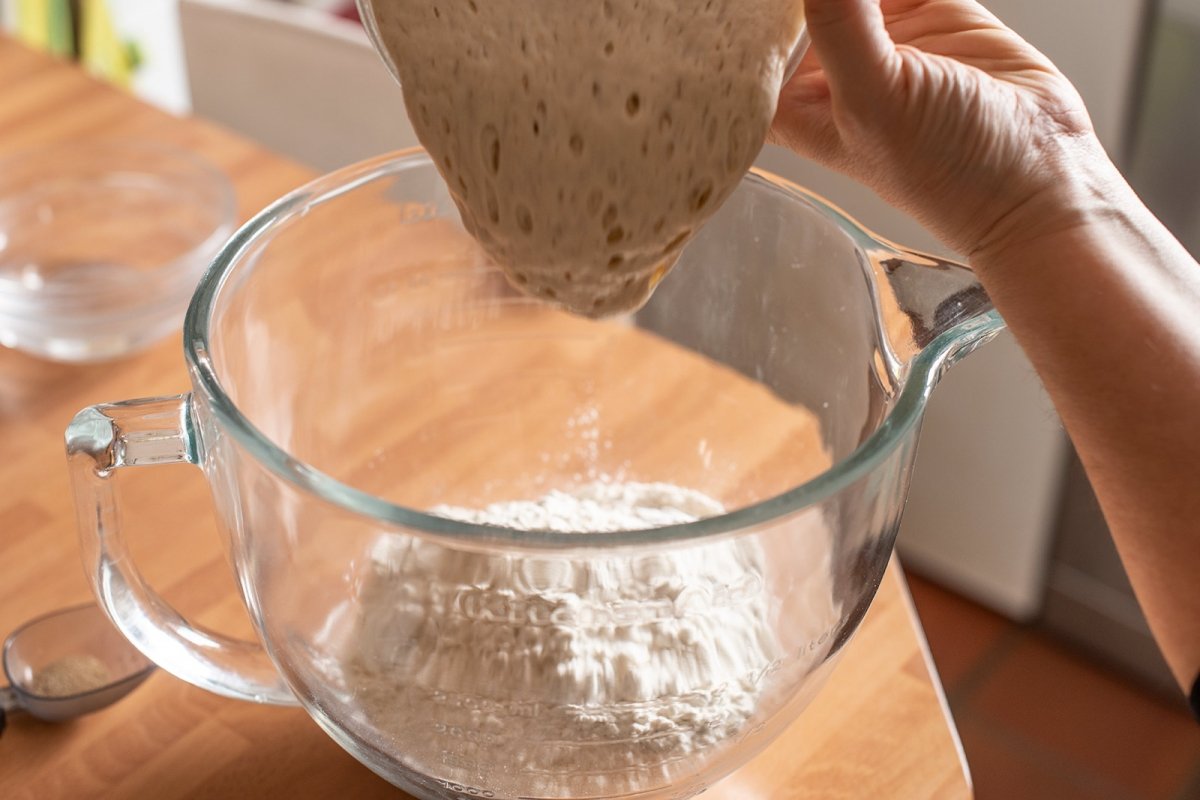
After mixing, let stand one hour for autolysis; this rest without salt or yeast facilitates subsequent kneading.
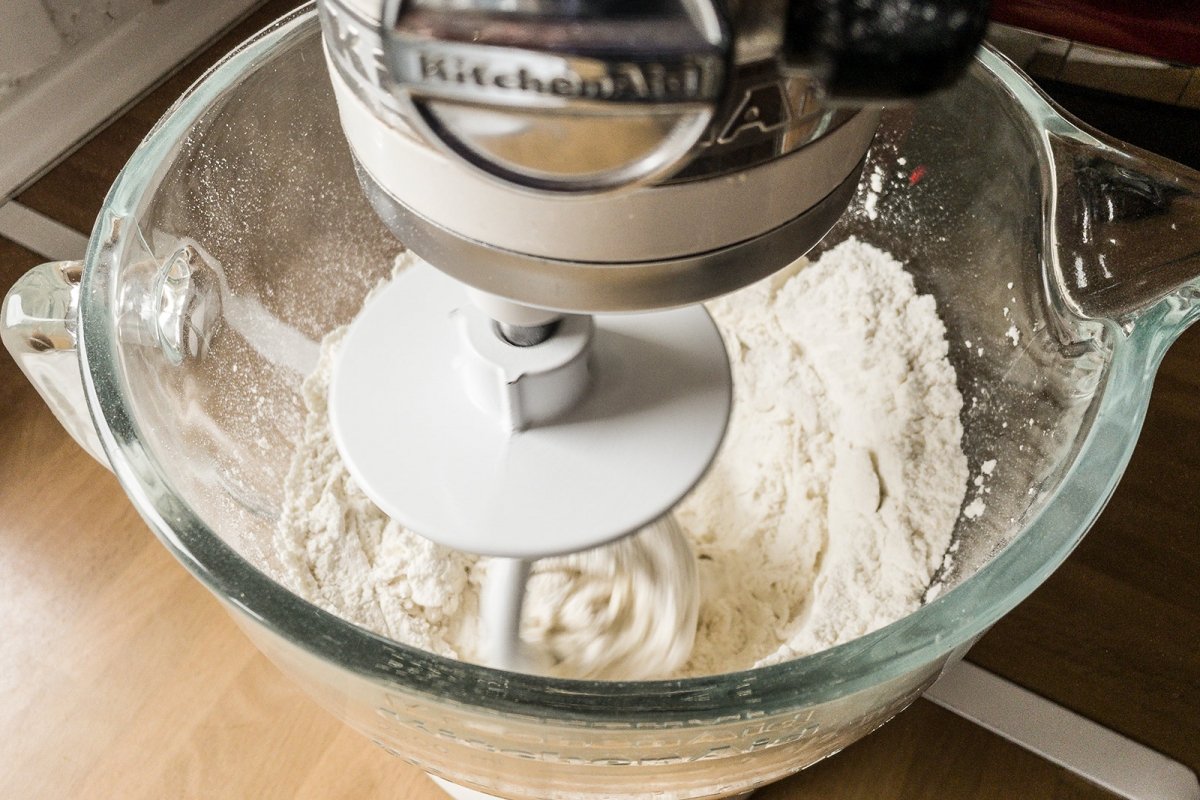
Add 8 g of salt and 1 g of dry baker’s yeast (or 3 g of fresh yeast) and begin to knead in 1-2 minute cycles separated by 10 minute rests. The kneading can be done with a robot or by hand.

The dough will become thinner and more elastic as the kneading progresses.
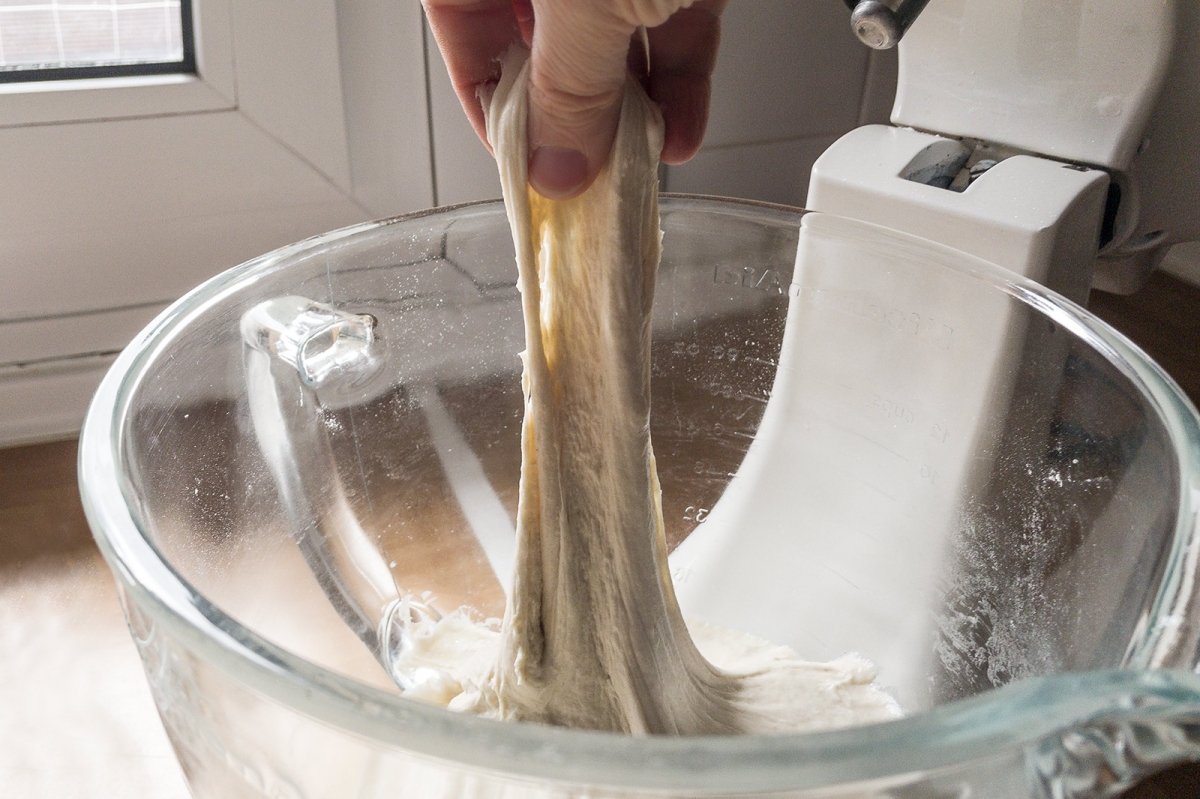
When the dough is very elastic, make a ball with it and put it in a greased container. Cover and let it double the volume. Throughout this first fermentation, a couple of folds can be made to increase the strength and structure of the dough. To make the folds of the baguettes, the dough is lifted without having to remove it from the container and folded in three parts, like the paper in an envelope.
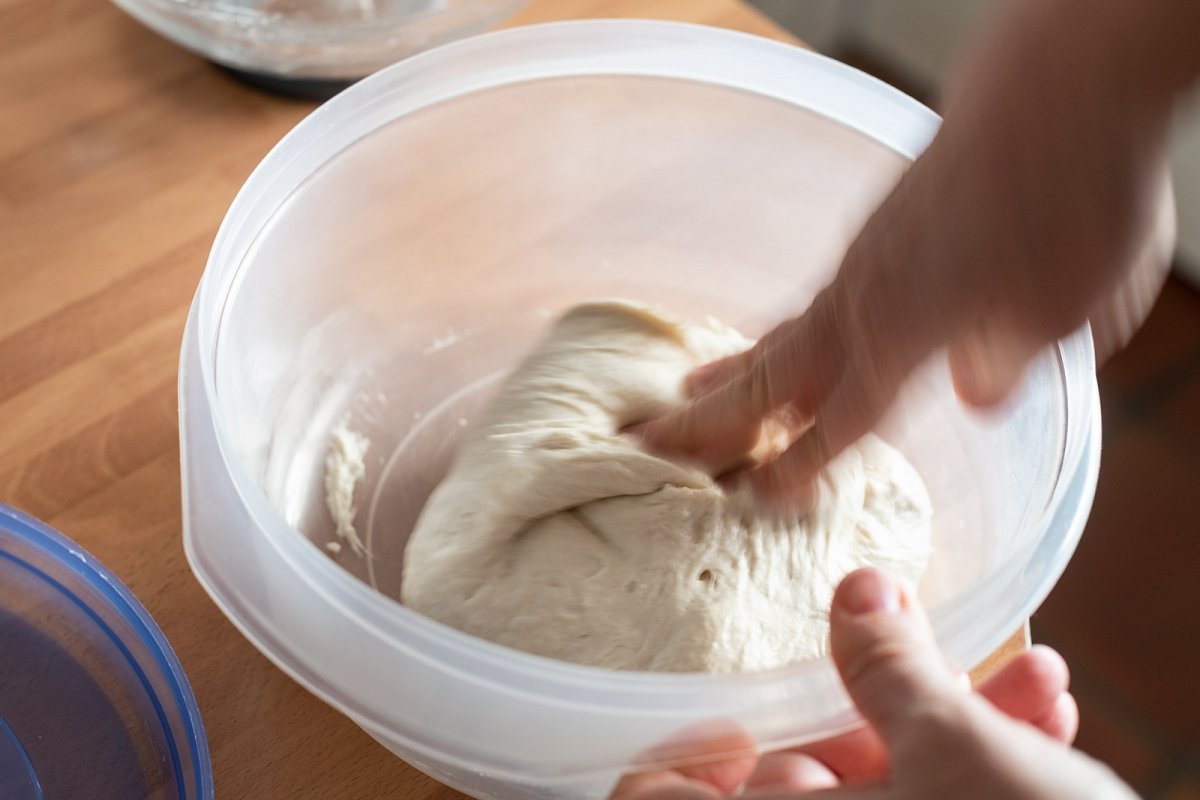
Once the dough has doubled in volume, it is transferred to a lightly floured countertop.
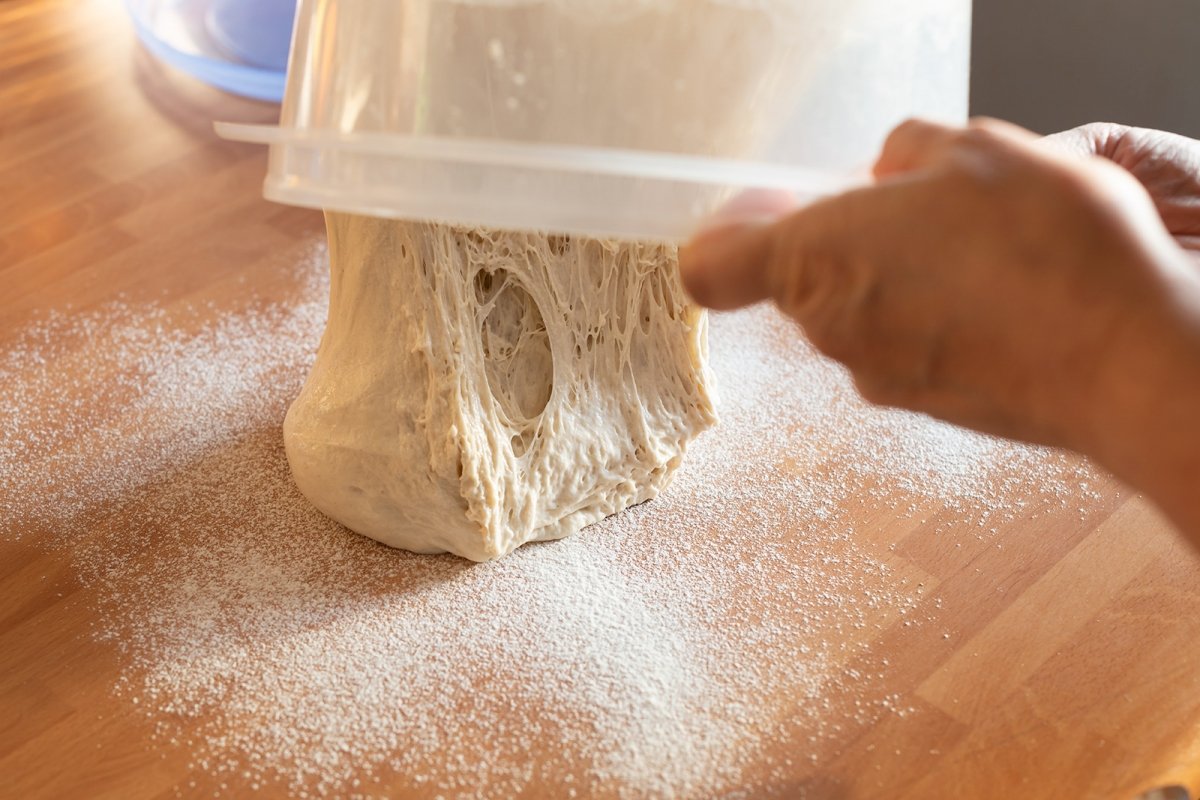
How to form the baguettes
Divide the dough into two or three portions, depending on the size of the oven; in a conventional domestic oven it is not easy to cook baguettes of more than 50 cm.
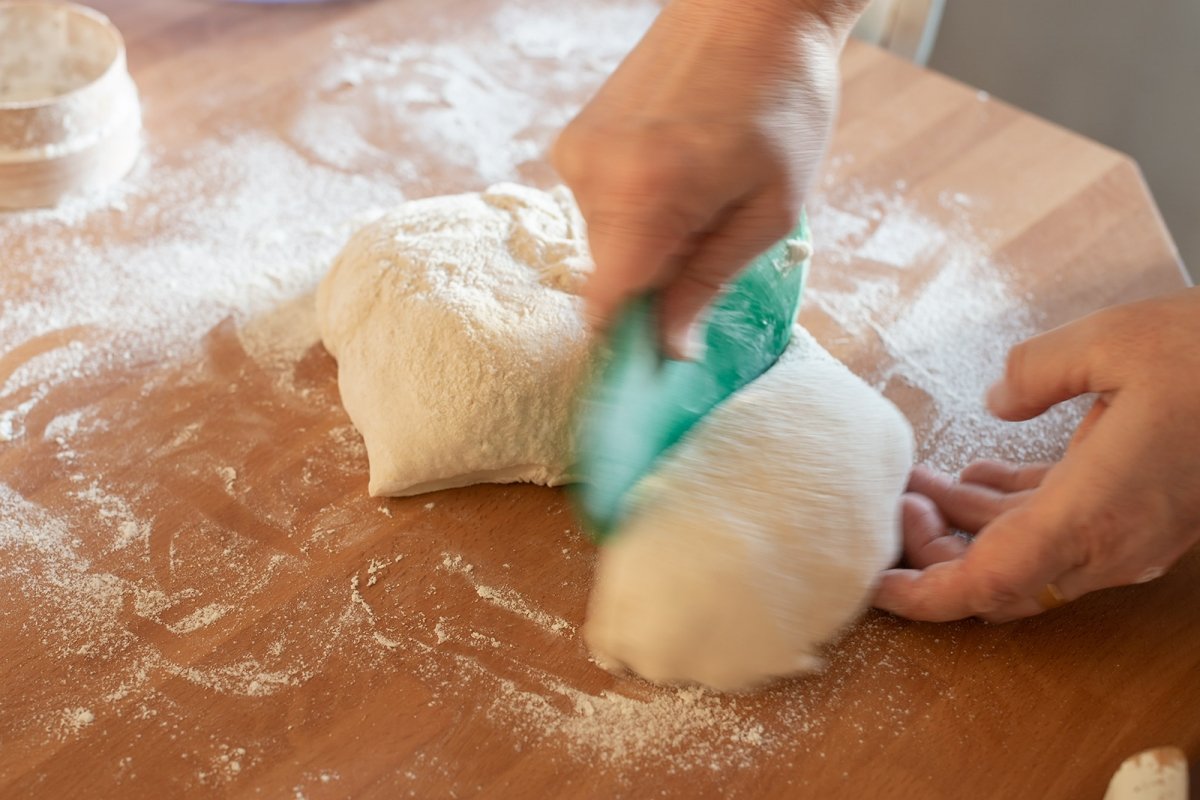
Weigh the portions of dough to check that they have similar weights, and equalize them by passing small pieces of dough from one portion to another.

Lightly spread the portions of dough and preform them by rolling them into a loose cylinder. Cover with plastic wrap and let rest for 20 minutes.
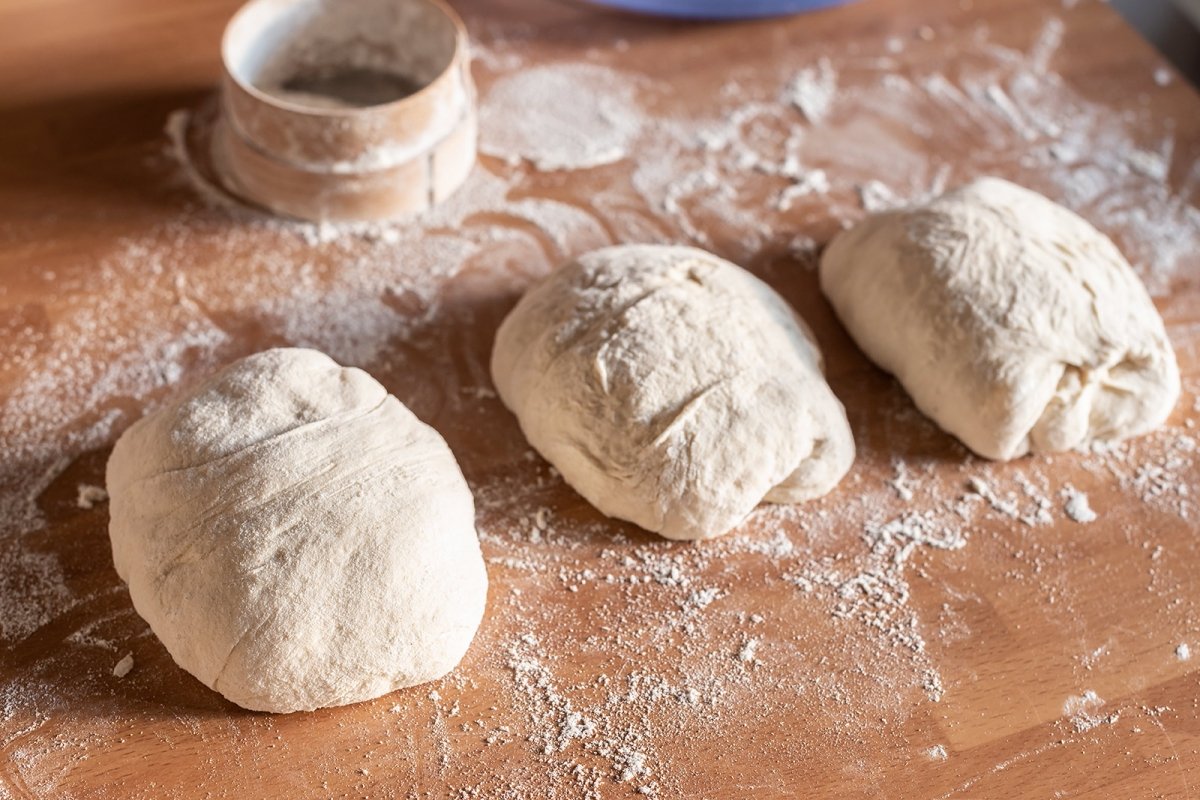
form each baguette as seen in the photos: take the first portion and remove it from the table with the scraper.
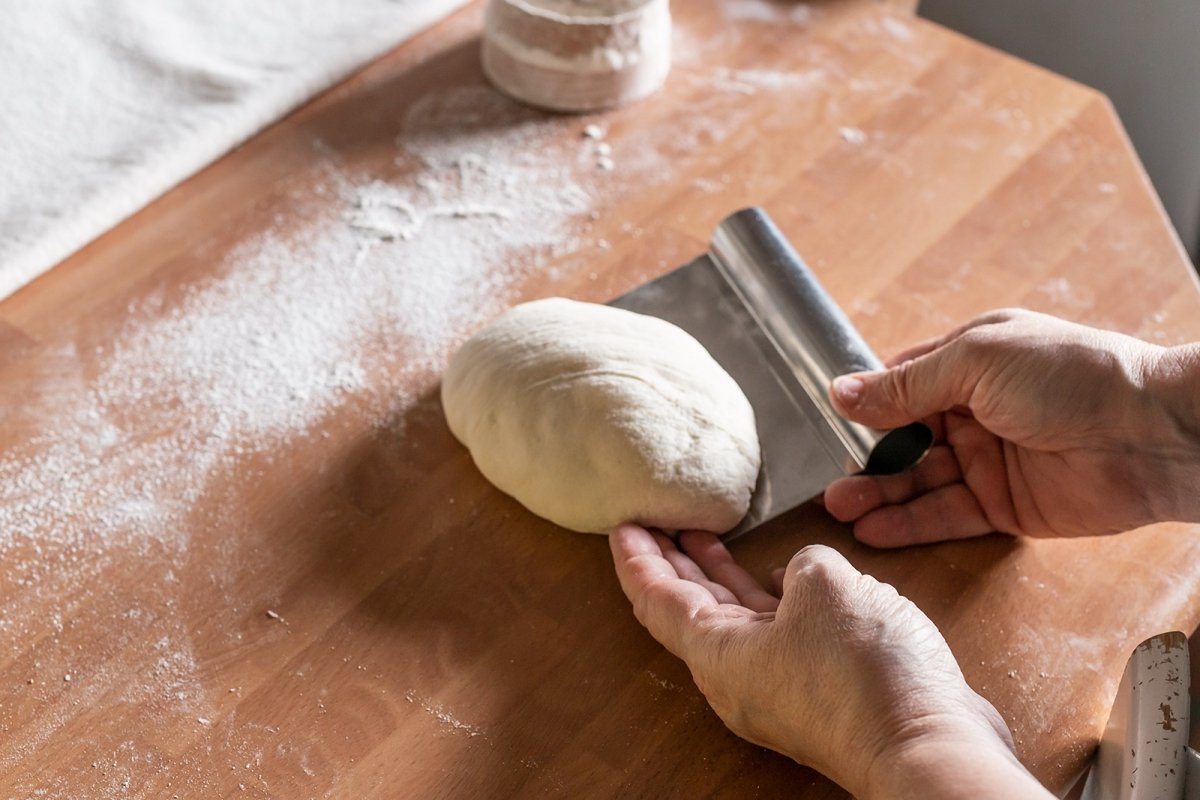
Flip each portion of preformed dough onto an area of the table with some flour, so that the back of the dough, in contact with the table, does not stick.
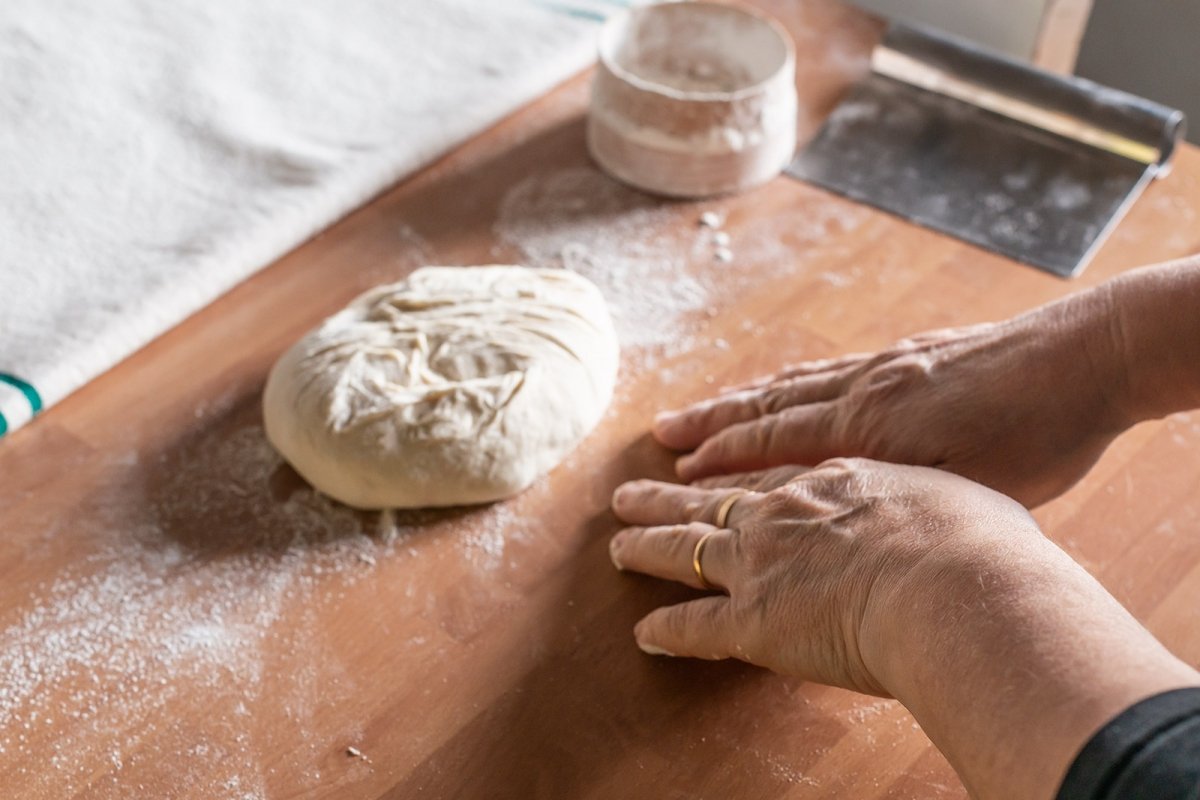
Take the portion of the dough to another area of the table without flouring and first form a rude square.
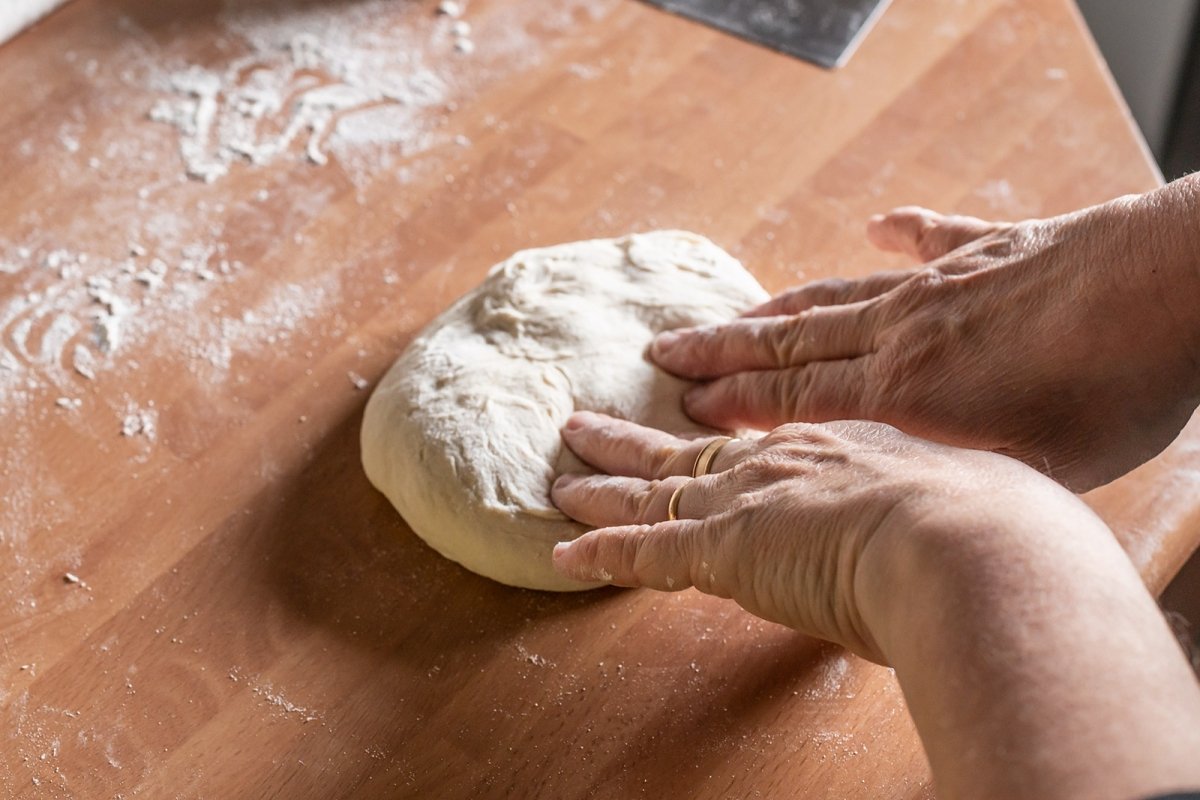
Fold the top half of the dough square on itself, towards the center, and press very gently with your fingers so that the dough sticks together.

Repeat the operation with the lower half and press again to seal.

Next, fold the upper half of the dough over the lower one and seal the union of both with the lower part of your hand, pressing firmly so that the cylinder formed during cooking does not unroll. The objective of all these bends is to give surface tension to the formed cylinder, so that the growth during fermentation and in the oven occurs upwards and, in this way, the bar is not crushed.
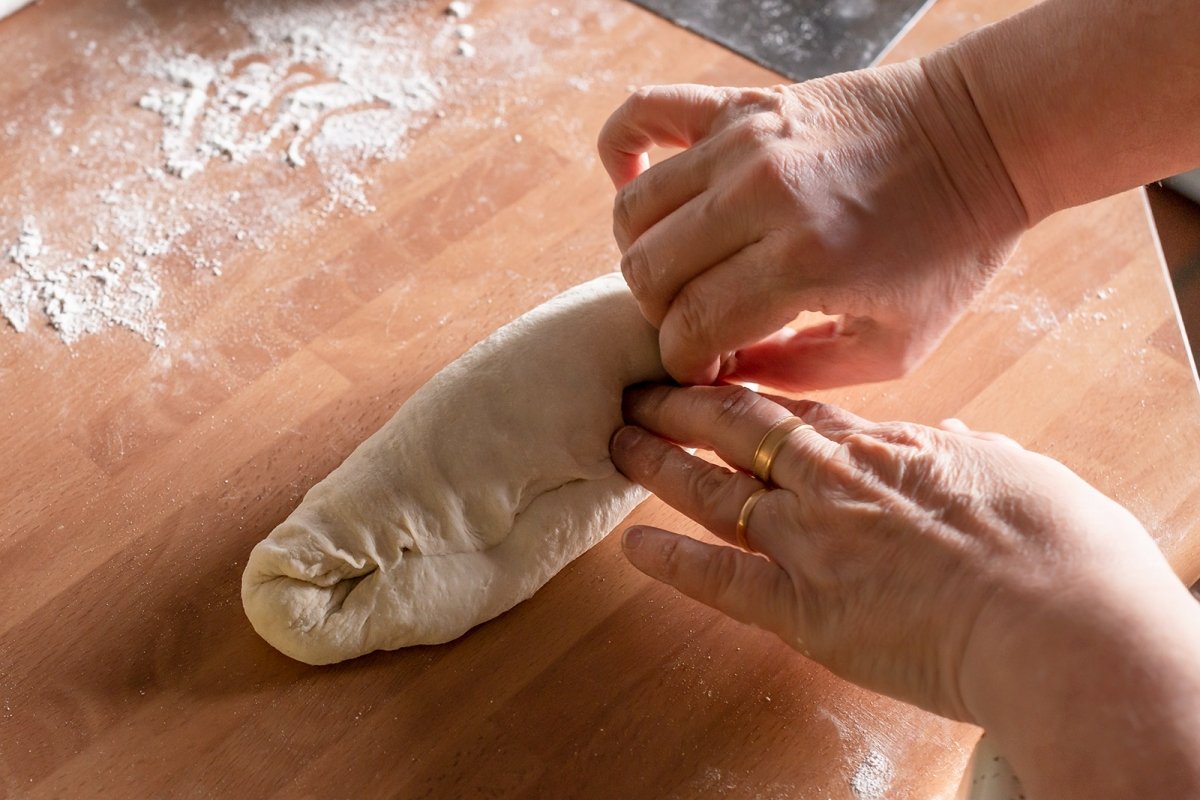
Place the formed dough cylinder in front of yourself and, starting with your hands placed in the center of the piece, roll it on the table, while moving your hands to the sides and stretching the dough, to make it longer the bar, as if we were stretching a plasticine cylinder.
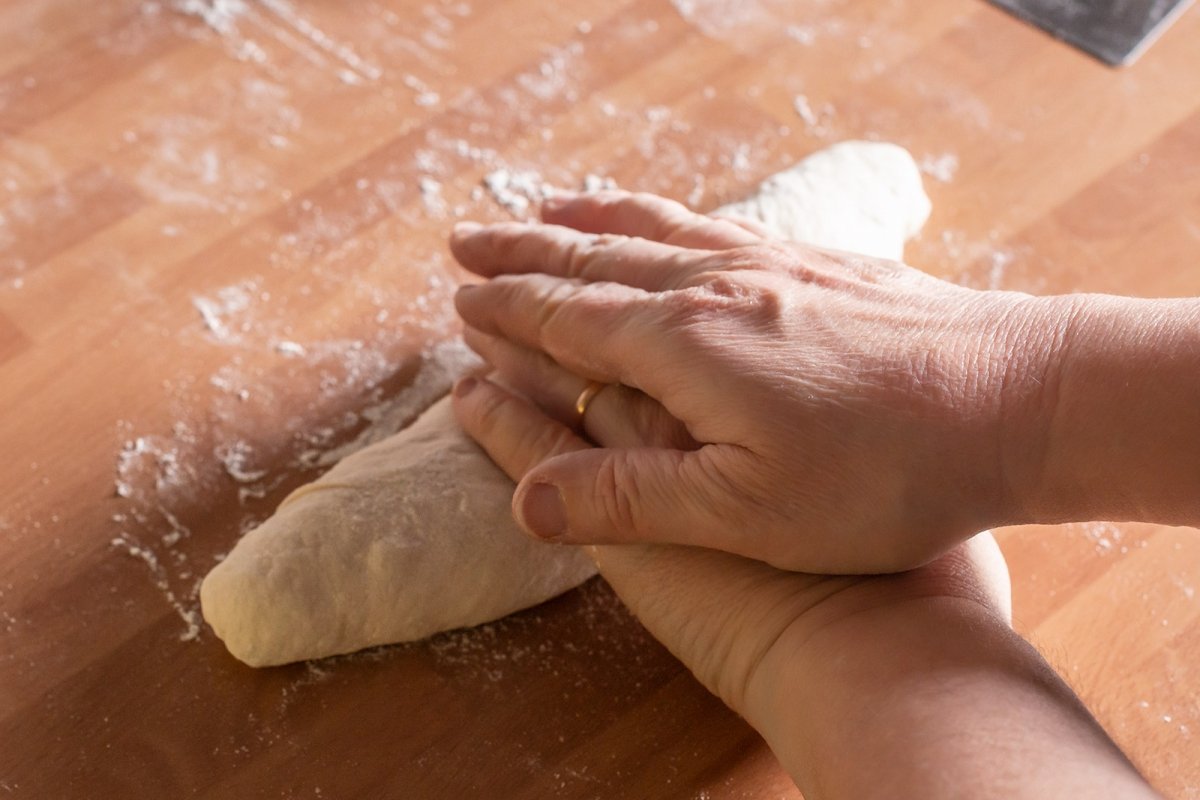
Upon reaching both ends, these must be refined by squeezing the dough more to form the tips of the baguette.
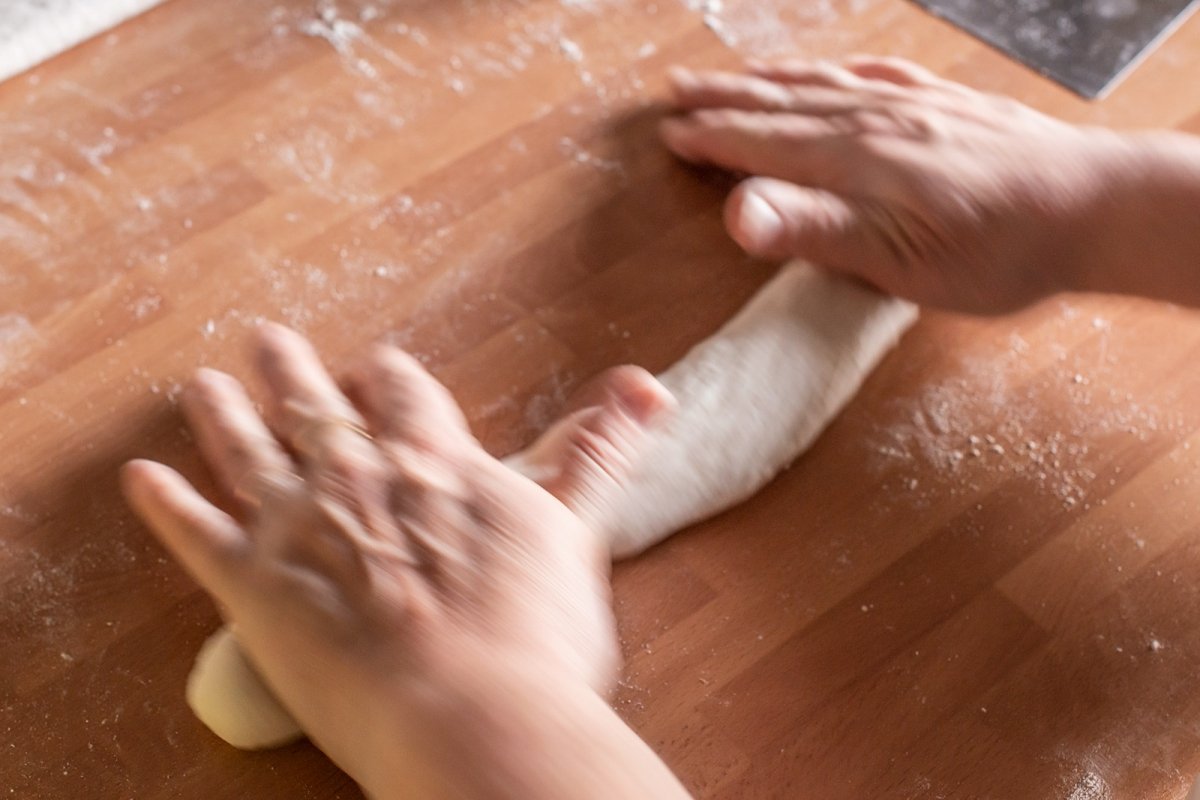
Gently transfer the bars to a well-floured cloth and turn them over so that they are seam side up, about 10 cm apart.
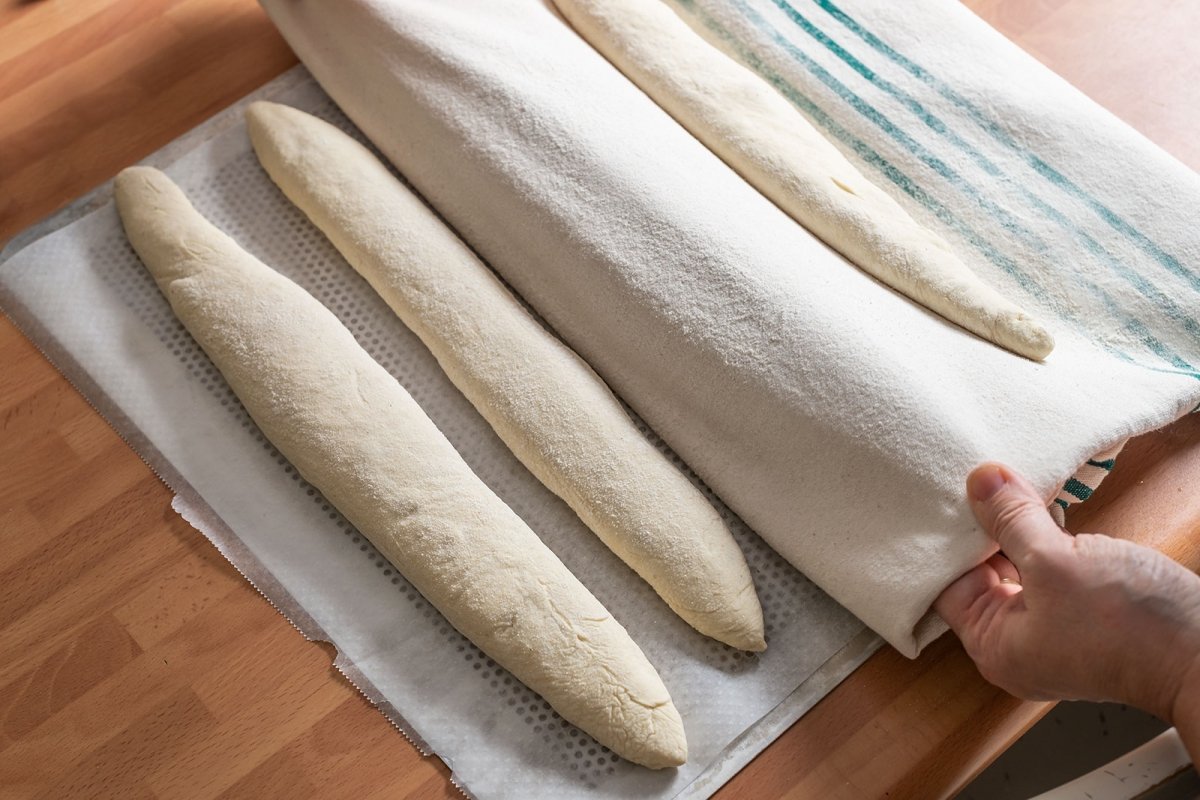
Raise the space in the cloth that remains between the bars to form a separation/containment that helps them rise upwards during fermentation, as can be seen in the following photo.

cover the baguettes with plastic wrap and leave to ferment a second time, between 45 and 60 minutes. We must not rush the fermentation, since the bars must open clearly during cooking. Meanwhile, put the oven to heat up to 250 °C so that it is ready when the bars are fermented.
Once fermented, with the help of the cloth, transfer the bars to a tray lined with baking paper and turn them over so that the joint of the shape is facing down. Next, grate the baguettes with a sharp knife or razor blade.
to grind the baguettesthe cuts must be made inclined with respect to the surface of the bread, that is, by tilting the blade. The arrangement of the cuts must be oblique with respect to the axis of the bar, very centered with respect to the width of the bar, and slightly overlapping, as seen in the photos.
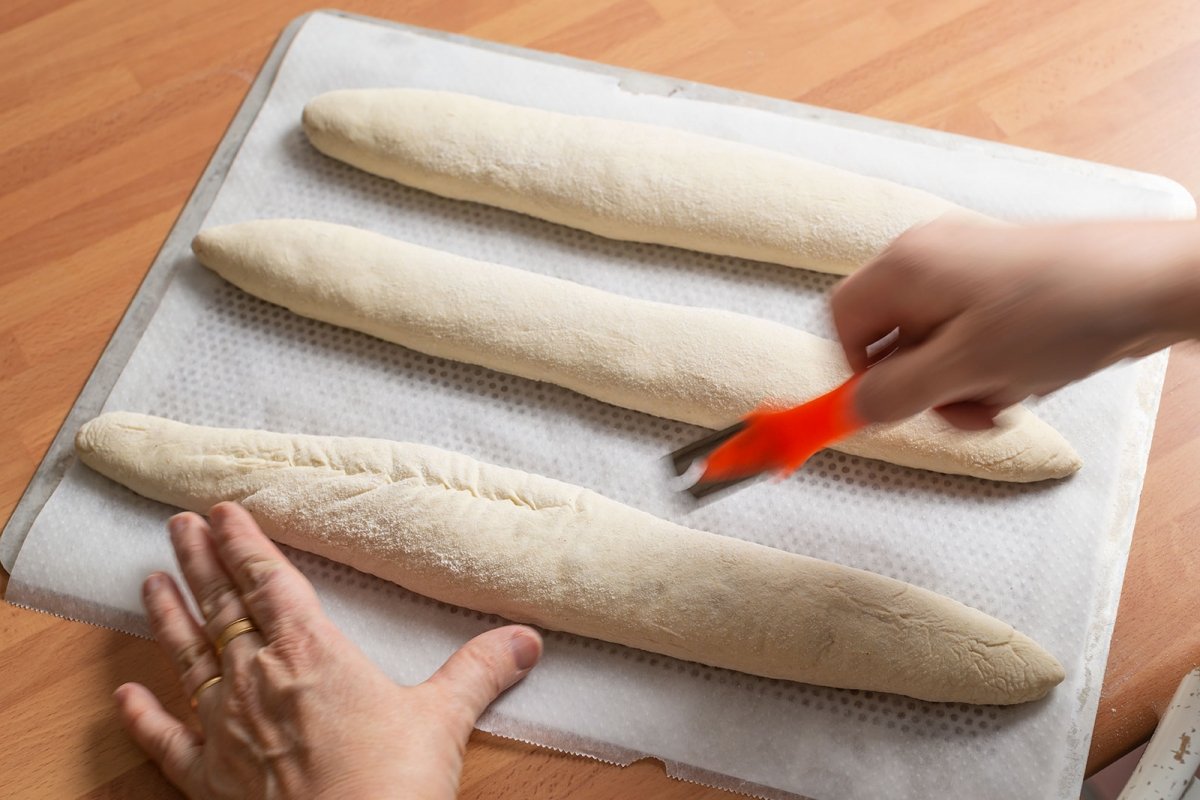
Put the bread in the oven and create steam as indicated in the recipe introduction. Close the oven immediately and cook the baguettes for 10 minutes. Lower the temperature to 200 °C and continue cooking for an additional 10-15 minutes, until the bread is golden brown. take out the baguettes Cool on a rack and do not open them until they have cooled completely.

Easy preparation summary
-
-
- Put the preferment ingredients in a bowl: flour, water and yeast. Mix and cover with plastic. Let ferment until bubbly, about 12 hours
-
-
-
- Weigh the ingredients of the final dough and mix the preferment only with the additional flour and water
-
-
-
- Let stand for one hour for autolysis
-
-
-
- Add the salt and yeast, and knead in 1-2 minute cycles with 10 minute rests.
-
-
-
- As the kneading progresses, the dough becomes thinner and more elastic.
-
-
-
- Make a ball with the dough, put it in a greased container, cover and let it double in volume. Meanwhile, make a couple of folds by lifting the dough, without having to remove it from the container, and folding it in three parts
-
-
-
- When the volume of the dough has doubled, transfer it to a floured worktop.
-
-
-
- Divide the dough into two or three parts depending on the size of the oven
-
-
-
- Weigh the portions of dough and equalize the weights
-
-
-
- Extend the portions of dough, preform them, cover with plastic film and let rest for 20 minutes.
-
-
-
- Take the first portion and peel it off the table to form each baguette
-
-
-
- Flip each serving onto an area of the table with flour
-
-
-
- Form a rough square with the portion of dough, in an area of the table without flouring
-
-
-
- Fold top half of dough square toward center and press to seal
-
-
-
- Repeat the operation with the other half and seal again
-
-
-
- Fold the upper half over the lower half and seal the joint by pressing firmly so that the cylinder does not unroll.
-
-
-
- Place the cylinder of dough in front and place your hands in the center of the piece to make it roll and stretch the dough. baguette
-
-
-
- Press the dough more at the ends to form the tips of the baguette
-
-
-
- Transfer the bars to a floured cloth, separated and with the seam facing up.
-
-
-
- Form, with the cloth, a gap between the bars
-
-
-
- Cover and let ferment a second time, between 45 and 60 minutes. Heat the oven to 250 °C. With the help of the cloth, transfer the bars to a tray with baking paper, with the seam facing down and brush the baguettes
-
-
-
- cook the baguettes at 250 ºC for the first 10 minutes and at 200 ºC for another 10-15 minutes, until golden. Let cool on a rack
-















Welcome to Sweet Eats Cakes
Where delectable dreams come to life in the form of exquisite confections! Sweet Eats Cakes isn't just about taste; it's about turning moments into memories. Our cakes are crafted with precision, attention to detail, and a sprinkle of magic to ensure that each slice is not just a treat for the taste buds but a feast for the eyes!